In the competitive landscape of B2B marketing, where customer acquisition costs continue to rise and buyer journeys become increasingly complex, the ability to convert website visitors into qualified leads has never been more critical. Recent research from Unbounce, analyzing over 41,000 landing pages and 57 million conversions, reveals that while the median conversion rate across all industries stands at 6.6%, B2B companies face unique challenges that often result in significantly lower performance [1]. More concerning, a joint study by Econsultancy and RedEye found that only 28% of companies are satisfied with their conversion rates, while 37% report being quite dissatisfied or very dissatisfied with their current performance [2].
The stakes are particularly high in B2B environments, where conversion rates vary dramatically by industry—from a low of 1.1% in B2B SaaS and software development to a high of 7.4% in legal services [3]. This wide variation underscores both the challenge and the opportunity: companies that master B2B conversion rate optimization (CRO) can achieve substantial competitive advantages, with businesses using CRO tools reporting an average return on investment of 223% [4]. As we advance into 2025, understanding and implementing sophisticated CRO strategies has evolved from a nice-to-have marketing tactic to an essential business imperative that directly impacts revenue growth and market positioning.
Why B2B CRO is Critical for 2025 and Beyond
The business landscape of 2025 presents unprecedented challenges and opportunities for B2B organizations. Digital transformation has fundamentally altered buyer behavior, with B2B customers now conducting extensive research independently before engaging with sales teams. This shift has placed enormous pressure on digital touchpoints to perform effectively, making conversion rate optimization not just a marketing consideration but a strategic business imperative.
The economic environment adds another layer of complexity. With marketing budgets under increased scrutiny and customer acquisition costs rising across industries, the ability to maximize returns from existing traffic has become essential for sustainable growth. Companies can no longer rely solely on driving more traffic to their websites; they must focus on converting the visitors they already attract more effectively.
Furthermore, the B2B buying process has become increasingly sophisticated, with multiple stakeholders involved in decision-making and longer sales cycles becoming the norm. Research indicates that B2B buyers typically consider six or more competitors before making a decision, and the customer journey often extends beyond two months [5]. This extended evaluation period means that every touchpoint must be optimized to maintain engagement and guide prospects toward conversion.
The technological landscape also presents new opportunities. Advances in artificial intelligence, machine learning, and data analytics have made sophisticated CRO techniques accessible to businesses of all sizes. Heat mapping, session recording, and predictive analytics tools now provide unprecedented insights into user behavior, enabling more targeted and effective optimization efforts.
Perhaps most importantly, the competitive advantage gained through superior conversion optimization compounds over time. Companies that consistently convert visitors at higher rates not only generate more immediate revenue but also gather more customer data, enabling further refinement of their strategies. This creates a virtuous cycle where optimization efforts become increasingly effective, widening the gap between high-performing and average-performing organizations.
Understanding B2B Conversion Rate Optimization
B2B conversion rate optimization represents a systematic approach to increasing the percentage of website visitors who complete desired actions, whether filling out forms, downloading resources, or requesting demonstrations. However, the B2B context introduces complexities that distinguish it significantly from B2C optimization efforts.
The fundamental calculation remains straightforward: conversion rate equals the number of desired actions taken divided by the opportunities for those actions to occur, multiplied by 100 [6]. On a landing page, this translates to form submissions divided by landing page visits. At a conference booth, it becomes badge scans divided by booth visitors. For product pages, it represents purchases completed divided by product page visits.
However, B2B conversion optimization extends far beyond simple mathematical calculations. As Daniel Lynch, President and Owner of Empathy First Media, explains, “A conversation rate optimization is more than just a conversion. The conversion can be a vanity metric. But, conversations are what the goals should always be with marketing” [7]. This perspective highlights a crucial distinction: B2B CRO should focus on generating meaningful interactions that lead to business relationships rather than merely increasing numerical conversion rates.
B2B Conversion Rates by Industry (2025)
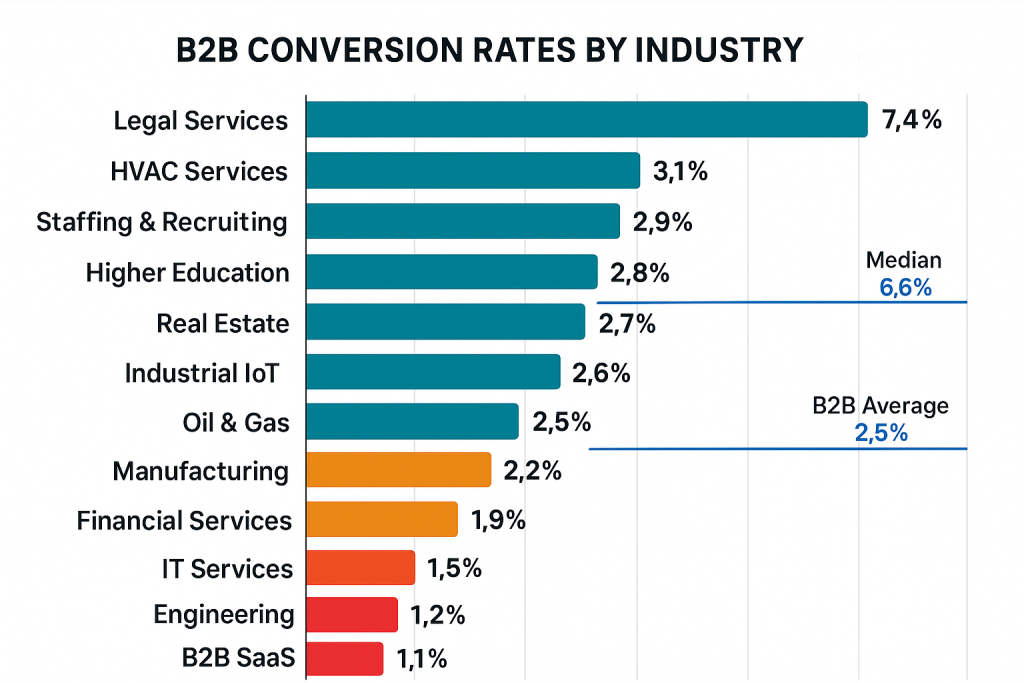
The B2B environment presents unique characteristics that influence optimization strategies. Unlike B2C transactions, B2B conversions typically involve multiple decision-makers, longer consideration periods, and higher-value transactions. The buying process often requires extensive evaluation of technical specifications, ROI calculations, and integration considerations. These factors mean that B2B websites must serve different functions throughout the buyer journey, from initial awareness and education to detailed technical evaluation and final decision support.
Industry benchmarks reveal significant variation in B2B conversion rates across sectors. According to comprehensive research by First Page Sage analyzing conversion rates across 25 B2B industries, legal services achieve the highest conversion rates at 7.4%, followed by HVAC services at 3.1% and staffing and recruiting at 2.9% [8]. At the lower end of the spectrum, B2B SaaS and software development companies typically see conversion rates around 1.1%, while engineering firms average 1.2%.
| Industry | Conversion Rate | Performance Tier |
|---|---|---|
| Legal Services | 7.4% | High |
| HVAC Services | 3.1% | High |
| Staffing & Recruiting | 2.9% | Medium |
| Higher Education | 2.8% | Medium |
| Real Estate | 2.7% | Medium |
| Industrial IoT | 2.6% | Medium |
| Oil & Gas | 2.5% | Medium |
| PCB Design & Manufacturing | 2.4% | Medium |
| Manufacturing | 2.2% | Medium |
| Addiction Treatment | 2.1% | Medium |
These variations reflect the different nature of buying decisions across industries. Legal services, for example, often involve urgent needs and local searches, leading to higher conversion rates. In contrast, B2B SaaS purchases typically require extensive evaluation periods and involve multiple stakeholders, resulting in lower immediate conversion rates but potentially higher lifetime values.
The distinction between B2B and B2C conversion optimization extends beyond industry benchmarks to fundamental strategic approaches. B2C optimization often focuses on emotional triggers, impulse purchases, and immediate gratification. B2B optimization, conversely, must address rational decision-making processes, demonstrate clear return on investment, and provide comprehensive information to support complex purchasing decisions.
The Current State of B2B Conversion Rates
The current landscape of B2B conversion rates reveals both significant opportunities and persistent challenges across industries. Comprehensive analysis of industry performance provides crucial context for understanding where optimization efforts can yield the greatest returns.
Unbounce’s extensive Conversion Benchmark Report, analyzing 41,000 landing pages, 464 million pageviews, and 57 million conversions, establishes a median conversion rate of 6.6% across all industries [9]. However, this overall figure masks substantial variation within B2B sectors. The SaaS category, representing a significant portion of B2B businesses, achieves a median conversion rate of 3.8%, while commercial and professional service providers perform better at 6.2%.
B2B vs B2C Conversion Optimization Differences
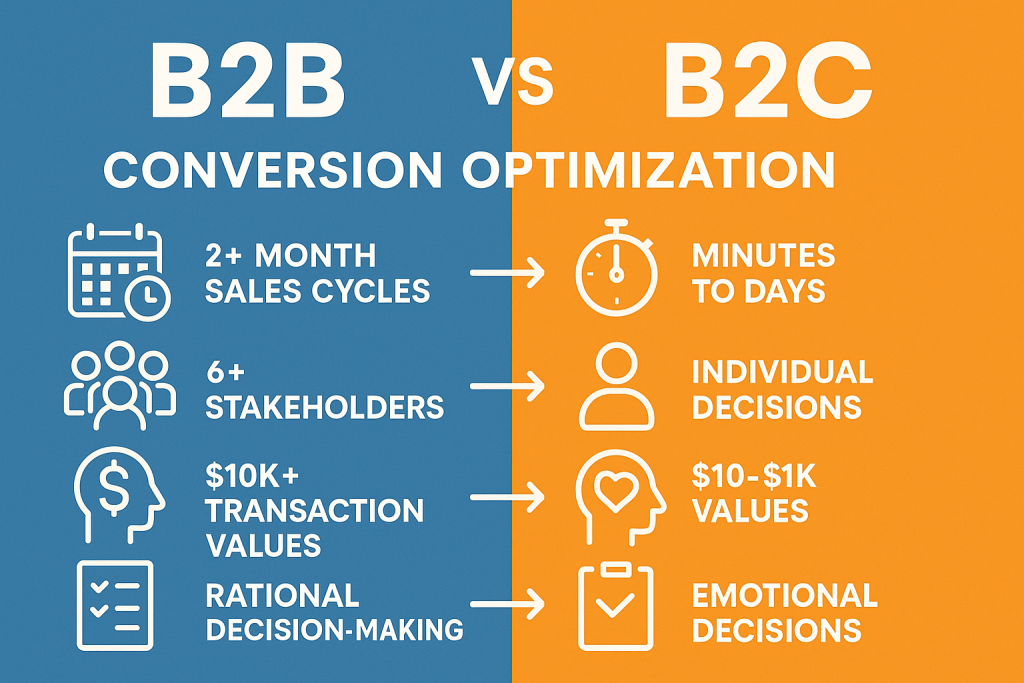
B2B and B2C conversion optimization require fundamentally different approaches due to varying sales cycles, decision-making processes, and transaction values.
More granular industry analysis reveals the full spectrum of B2B conversion performance. Legal services lead with conversion rates of 7.4%, benefiting from urgent client needs and localized search behavior. HVAC services follow at 3.1%, driven by immediate service requirements and geographic targeting. Industrial IoT companies achieve 2.6% conversion rates, reflecting the complex nature of their solutions and longer sales cycles.
Technology-focused B2B companies face particular challenges. B2B SaaS companies and software development firms both average just 1.1% conversion rates, reflecting the complexity of their offerings and the extensive evaluation processes typical in technology purchases [10]. Engineering firms perform slightly better at 1.2%, while IT and managed services companies achieve 1.5% conversion rates.
The satisfaction levels among B2B marketers regarding their conversion performance paint a concerning picture. Research by Econsultancy and RedEye found that only 28% of companies express satisfaction with their conversion rates, while 37% report being quite dissatisfied or very dissatisfied [11]. This dissatisfaction stems from several factors, including the complexity of B2B sales processes, the challenge of measuring attribution across long sales cycles, and the difficulty of optimizing for multiple stakeholder involvement.
Several factors contribute to the current state of B2B conversion challenges. The increasing sophistication of B2B buyers means they conduct extensive research independently before engaging with vendors. This behavior, while positive for informed decision-making, creates challenges for companies trying to capture leads early in the buying process. Additionally, the proliferation of content and options available to buyers has increased competition for attention and raised expectations for website experiences.
Mobile optimization presents another significant challenge in the current B2B landscape. While desktop conversion rates average 4.03%, mobile performance typically lags significantly [12]. This disparity is particularly problematic as mobile usage continues to grow, even in B2B contexts where desktop usage was traditionally dominant.
Form abandonment represents a critical pain point in current B2B conversion performance. Research indicates that 27% of form fillers abandon forms that take too long to complete [13]. This statistic highlights the importance of balancing information collection needs with user experience considerations. B2B companies often require more information from prospects than B2C businesses, creating inherent tension between lead qualification and conversion optimization.
Essential Strategy 1: Create Compelling Landing Pages
The foundation of effective B2B conversion rate optimization lies in creating compelling, purpose-built landing pages that serve specific audiences and objectives. Unlike generic homepage experiences that attempt to serve all visitors, strategic landing page development enables precise targeting and messaging that resonates with specific buyer personas and journey stages.
The strategic importance of dedicated landing pages cannot be overstated in B2B environments. As conversion optimization experts emphasize, relying entirely on homepages for conversion activities severely limits performance potential [16]. Homepages must serve visitors of all shapes and sizes, representing different buying stages, industries, and needs. In contrast, landing pages can be designed for specific visitor types with predictable characteristics and requirements.
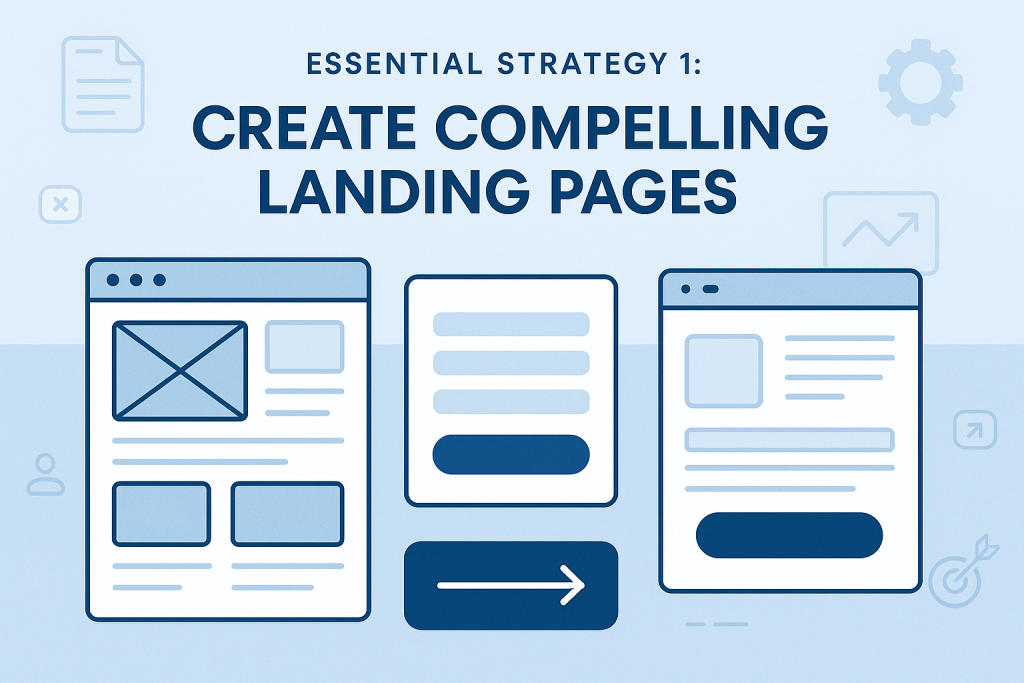
This specificity enables powerful messaging optimization. When companies know how far along the buying journey a visitor likely is and which industry they represent based on the landing page they’ve accessed, they can heavily tailor messaging and positioning to match those specific needs. More tailored messaging directly correlates with higher conversion likelihood, as visitors encounter content that directly addresses their particular challenges and objectives.
The construction of compelling B2B landing pages requires careful attention to several critical elements. The value proposition must be immediately clear and specifically relevant to the target audience. Generic statements about “improving efficiency” or “reducing costs” lack the specificity needed to capture attention in competitive B2B markets. Instead, effective landing pages articulate precise benefits in measurable terms, such as “reduce operational costs by 30%” or “increase productivity by 25% within 90 days.”
Industry-specific landing page strategies have proven particularly effective across different B2B sectors. Legal services companies achieve their industry-leading 7.4% conversion rates partly through creating in-depth, branded guides that offer appetizer portions of analysis around recent or highly searched laws [17]. This approach demonstrates expertise while providing immediate value to potential clients.
Manufacturing companies optimize their landing pages by publishing detailed product pages that highlight quality, price, and ways their products exceed industry benchmarks, including customer logos when possible [18]. This strategy addresses the technical evaluation needs typical in manufacturing purchase decisions while building credibility through social proof.
B2B SaaS companies, despite facing conversion challenges with average rates of 1.1%, can improve performance by creating presentation decks that address specific problems their software solves and automatically sending these to customers who submit email addresses [19]. This approach provides immediate value while beginning the nurturing process essential in longer B2B sales cycles.
Essential Strategy 2: Simplify Customer Experiences
The complexity inherent in B2B sales processes often leads companies to create unnecessarily complicated customer experiences that hinder rather than help conversion performance. Simplification represents one of the most impactful yet frequently overlooked optimization strategies, with the potential to dramatically improve conversion rates across all touchpoints.
The challenge of complexity in B2B environments stems from legitimate business needs. B2B companies typically require more information from prospects than B2C businesses, need to qualify leads more thoroughly, and must address the concerns of multiple stakeholders. However, these requirements often result in overly complicated sales funnels and customer experiences that lose potential conversions due to friction and confusion.
Research from the Baymard Institute reveals that 22% of customers abandon purchases because checkout processes are too long or complicated [21]. While this research focuses on e-commerce, the principle applies equally to B2B lead generation and conversion processes. Every additional step, form field, or decision point represents a potential exit opportunity for prospects.
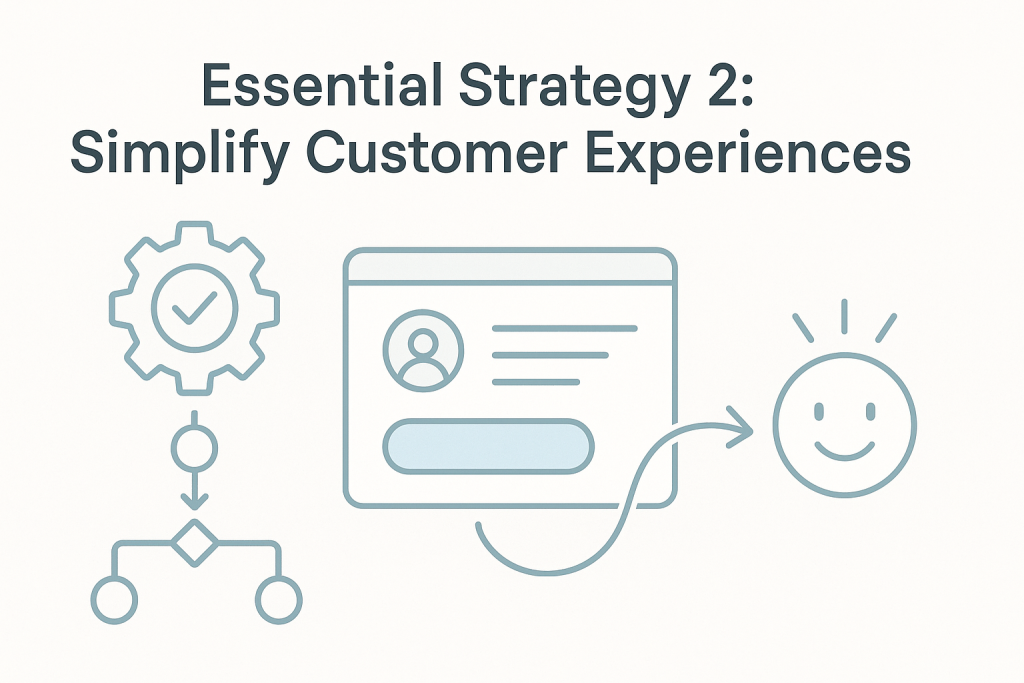
Form optimization represents one of the most immediate opportunities for simplification. B2B forms often request extensive information upfront, including company details, budget ranges, implementation timelines, and technical requirements. While this information is valuable for sales qualification, requesting it too early in the process creates unnecessary friction. Research shows that 27% of form fillers abandon forms that take too long to complete [22].
Effective form simplification strategies involve progressive profiling, where basic information is collected initially and additional details are gathered through subsequent interactions. Initial forms might request only name and email address, with company size, budget, and specific needs collected through follow-up communications or during sales conversations. This approach reduces initial friction while still enabling comprehensive lead qualification.
Typical B2B Conversion Funnel Analysis
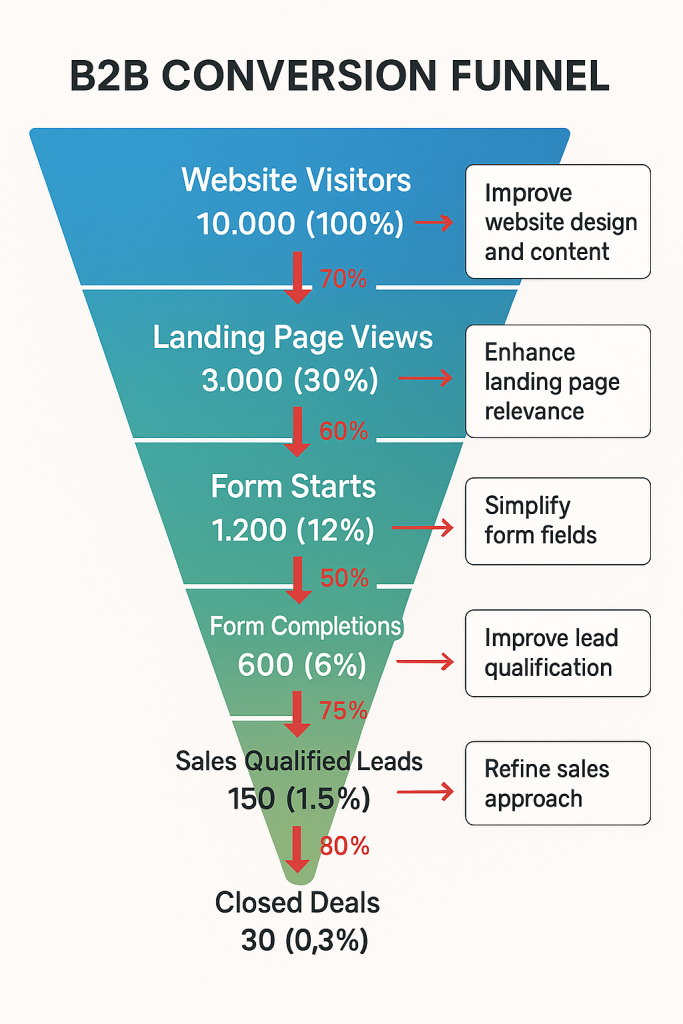
Typical B2B conversion funnels show significant drop-offs at each stage, highlighting opportunities for simplification and optimization.
Essential Strategy 3: Leverage Data-Driven Insights
The evolution of analytics and artificial intelligence has transformed B2B conversion rate optimization from a practice based on intuition and best practices to a sophisticated, data-driven discipline. Modern CRO leverages advanced technologies to understand user behavior at unprecedented levels of detail, enabling precise optimization strategies that deliver measurable results.
The foundation of data-driven CRO lies in comprehensive user behavior analysis. Traditional web analytics provide valuable insights into traffic patterns and basic conversion metrics, but advanced optimization requires deeper understanding of how users interact with websites and where they encounter friction. Heat mapping technology creates visual representations of user attention and interaction patterns, revealing which elements attract focus and which are ignored.
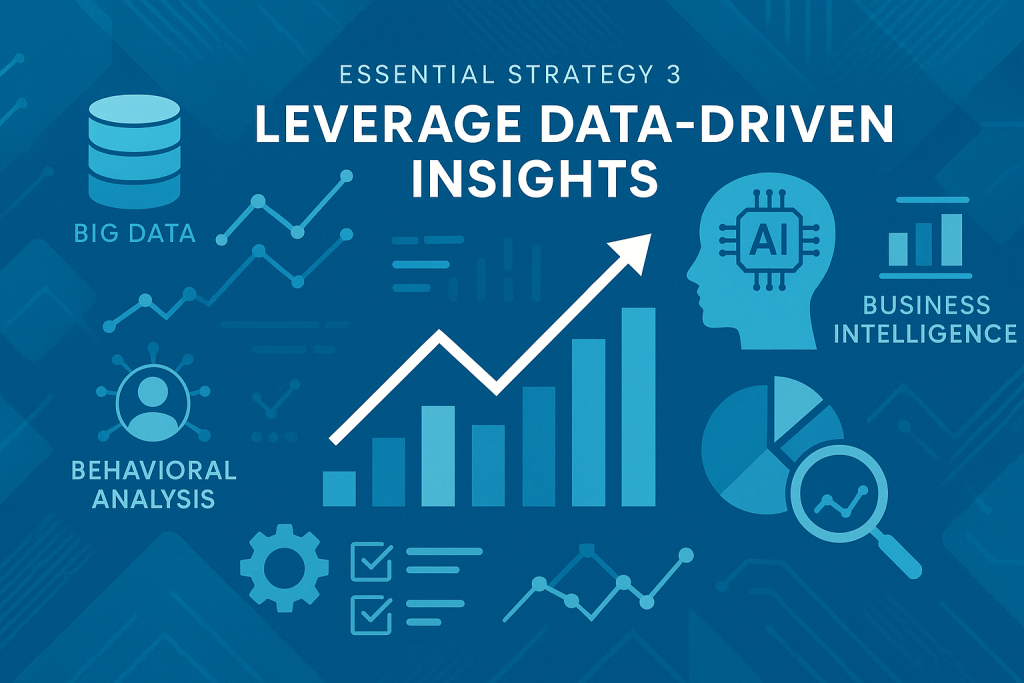
Session recording capabilities extend this analysis by providing actual recordings of user sessions, enabling optimization teams to observe real user behavior rather than relying on aggregated data. As Daniel Lynch, an expert in B2B conversion optimization, explains, “It’s super important that you identify with their cursor. What did they highlight? What did they focus on their screen?” [26]. This granular level of insight enables identification of specific friction points and optimization opportunities that would be invisible in traditional analytics.
The application of artificial intelligence to conversion optimization has opened new possibilities for personalization and predictive analysis. Machine learning algorithms can analyze vast amounts of user data to identify patterns and predict which visitors are most likely to convert. This predictive capability enables dynamic content presentation and personalized experiences that adapt to individual user characteristics and behavior patterns.
Microsegmentation represents a powerful application of data-driven insights in B2B environments. Traditional segmentation approaches based on company size or industry provide limited optimization opportunities. Advanced microsegmentation analyzes multiple variables, including industry, region, company size, buying patterns, volume, shipment size, and transaction timing, to create highly specific customer segments [27]. These insights inform decisions about how to personalize value propositions and prioritize leads.
Essential Strategy 4: Implement Advanced Testing
Advanced testing methodologies form the backbone of successful B2B conversion rate optimization programs, providing the empirical foundation necessary to make informed optimization decisions in complex business environments. Unlike B2C testing, which can rely on large sample sizes and quick results, B2B testing requires sophisticated approaches that account for longer sales cycles, smaller traffic volumes, and multiple stakeholder involvement.
The strategic framework for B2B testing begins with hypothesis development based on comprehensive user research and business objectives. Effective hypotheses go beyond simple design changes to address fundamental questions about user motivation, value proposition presentation, and conversion barriers. Each hypothesis should be grounded in specific user insights and tied to measurable business outcomes rather than vanity metrics.
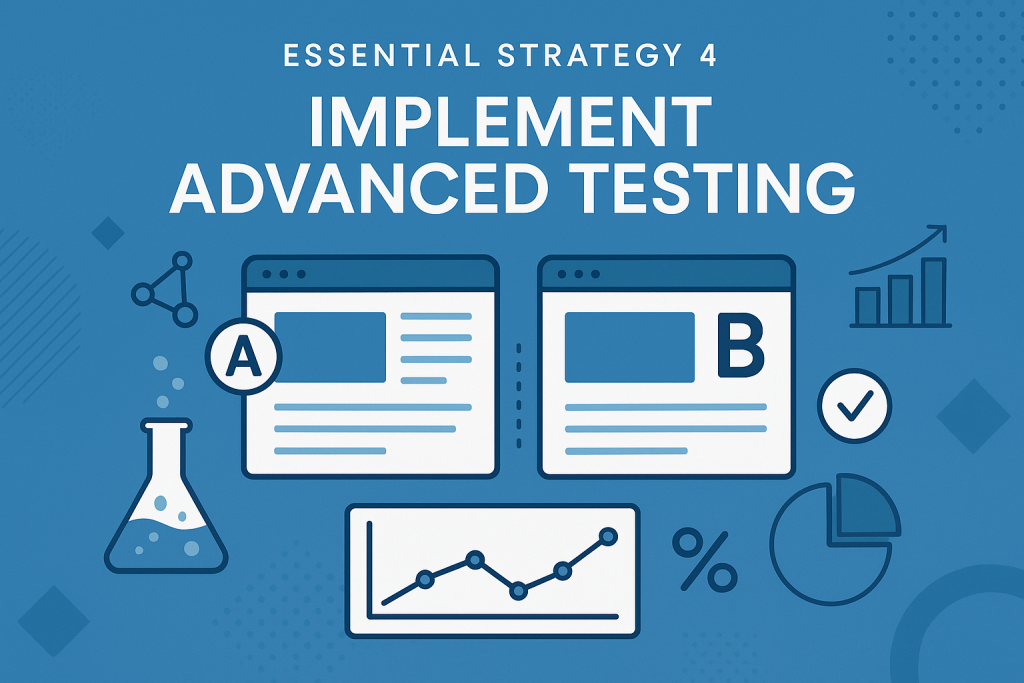
A/B testing in B2B environments requires careful consideration of statistical significance and sample size requirements. Lower traffic volumes typical in B2B websites mean that tests often require longer running periods to achieve statistical significance. This extended timeline necessitates careful test planning and prioritization to ensure that the most impactful hypotheses are tested first. Advanced testing programs utilize statistical power calculations to determine appropriate test durations and sample size requirements before launching experiments.
B2B A/B Testing Results Dashboard
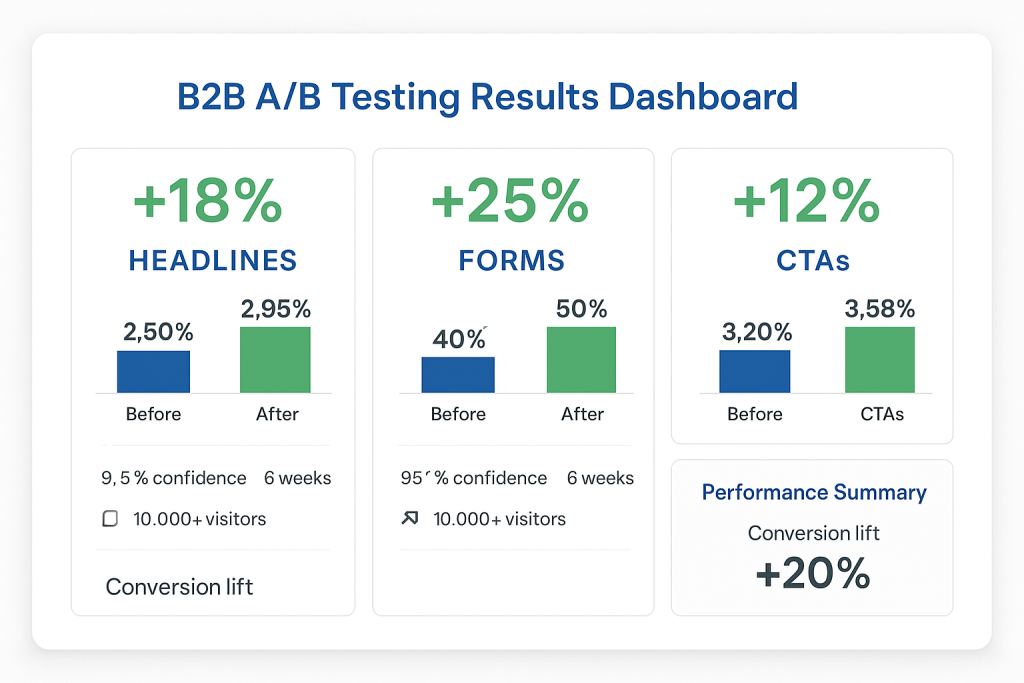
A/B testing in B2B environments can yield significant improvements across multiple conversion elements when properly implemented and measured.
Multivariate testing presents both opportunities and challenges in B2B optimization. While multivariate approaches can test multiple elements simultaneously, they require substantially larger sample sizes to achieve statistical significance. B2B companies with limited traffic may need to focus on sequential A/B tests rather than complex multivariate experiments. However, companies with sufficient traffic can leverage multivariate testing to understand interaction effects between different page elements.
Essential Strategy 5: Optimize for Mobile and User Experience
Mobile optimization in B2B environments has evolved from a nice-to-have feature to an essential component of conversion rate optimization strategies. While B2B interactions have traditionally been desktop-centric, the increasing prevalence of mobile device usage across all business functions demands sophisticated mobile optimization approaches that account for the unique characteristics of B2B decision-making processes.
The current state of mobile performance in B2B environments reveals significant optimization opportunities. Research indicates that desktop conversion rates average 4.03%, while mobile performance typically lags substantially [29]. This performance gap represents both a challenge and an opportunity, as companies that successfully optimize mobile experiences can gain competitive advantages while their competitors struggle with mobile conversion challenges.
Mobile B2B CRO Best Practices
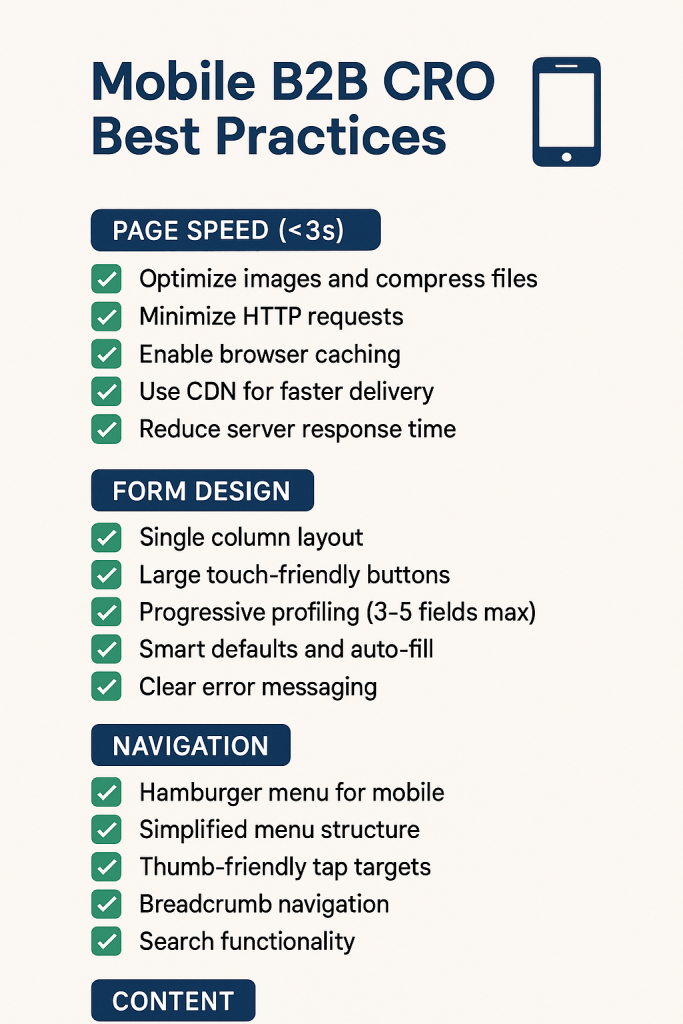
Mobile optimization for B2B requires attention to page speed, form design, navigation simplification, and content presentation across all devices.
The fundamental principles of mobile B2B optimization extend beyond responsive design to encompass comprehensive user experience considerations. Mobile users interact with content differently than desktop users, with shorter attention spans, different navigation patterns, and varying context of use. B2B mobile optimization must account for these behavioral differences while maintaining the comprehensive information presentation often required in business decision-making processes.
Page speed optimization represents a critical foundation for mobile B2B conversion success. Mobile users expect fast-loading pages, and even small delays can significantly impact conversion rates. The technical challenges of mobile page speed are compounded in B2B environments where pages often contain extensive content, multiple form fields, and complex functionality. Advanced optimization techniques, including image compression, code minification, and content delivery network implementation, have become essential for mobile performance.
Essential Strategy 6: Leverage Social Proof and Trust Signals
Social proof and trust signals play a particularly crucial role in B2B conversion optimization due to the high-stakes nature of business decisions and the need to establish credibility with multiple stakeholders. Unlike B2C purchases that may be driven by emotion or impulse, B2B decisions require extensive justification and risk mitigation, making trust signals essential components of effective conversion strategies.
The psychological foundation of social proof in B2B environments stems from the concept of risk reduction. Business decision-makers face personal and professional consequences for poor purchasing decisions, creating strong motivation to choose vendors with proven track records and satisfied customers. Social proof elements provide the evidence needed to justify decisions and reduce perceived risk associated with vendor selection.
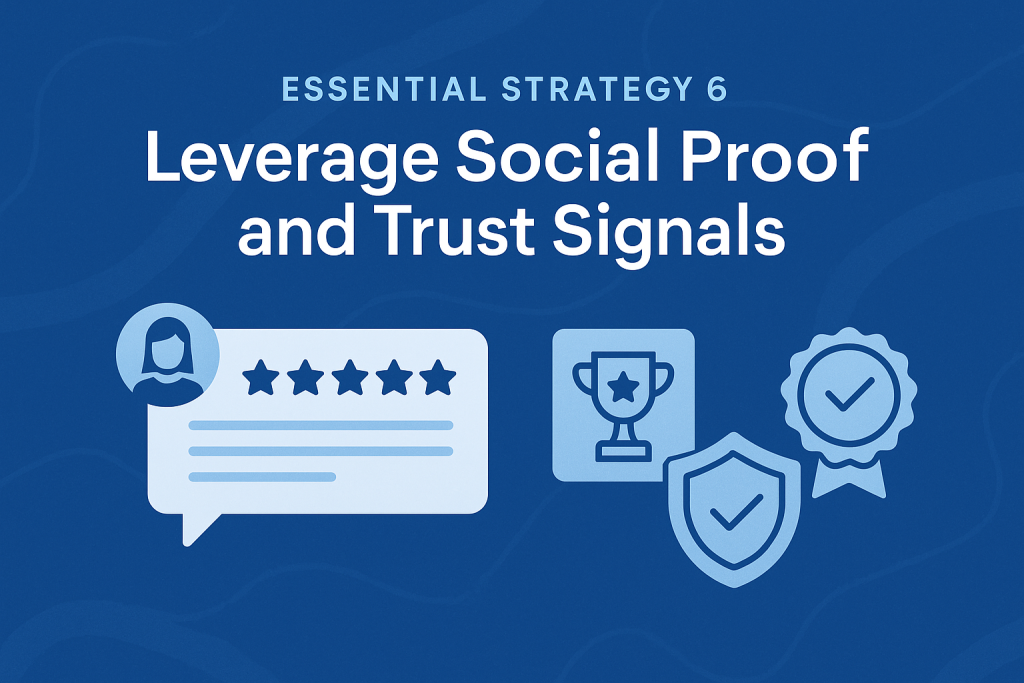
Customer testimonials represent one of the most powerful forms of social proof in B2B contexts, but their effectiveness depends heavily on specificity and relevance. Generic testimonials that praise general service quality provide limited conversion impact compared to detailed testimonials that describe specific business outcomes and measurable results. Effective B2B testimonials include quantifiable benefits, implementation details, and outcomes that resonate with similar prospects.
Industry awards and certifications provide third-party validation that can significantly impact B2B conversion rates. These credentials demonstrate expertise, quality, and industry recognition that help differentiate companies from competitors. The strategic presentation of awards and certifications should emphasize those most relevant to target audiences and clearly communicate their significance and credibility.
Security and compliance certifications have become increasingly important trust signals in B2B environments, particularly for technology companies and service providers handling sensitive business data. Certifications such as SOC 2, ISO 27001, and industry-specific compliance standards provide essential trust signals that may be prerequisites for consideration by enterprise buyers.
Essential Strategy 7: Personalize and Segment Experiences
Personalization and segmentation represent the evolution of B2B conversion rate optimization from one-size-fits-all approaches to sophisticated, individualized experiences that address the specific needs and characteristics of different buyer personas and journey stages. The complexity of B2B buying processes, involving multiple stakeholders with varying priorities and decision-making authority, makes personalization particularly valuable for improving conversion performance.
The foundation of effective B2B personalization lies in comprehensive audience segmentation that goes beyond traditional demographic categories to encompass behavioral, firmographic, and psychographic characteristics. Advanced segmentation approaches analyze multiple variables, including company size, industry, geographic location, technology stack, buying stage, and individual role within the organization, to create detailed buyer profiles that inform personalization strategies.
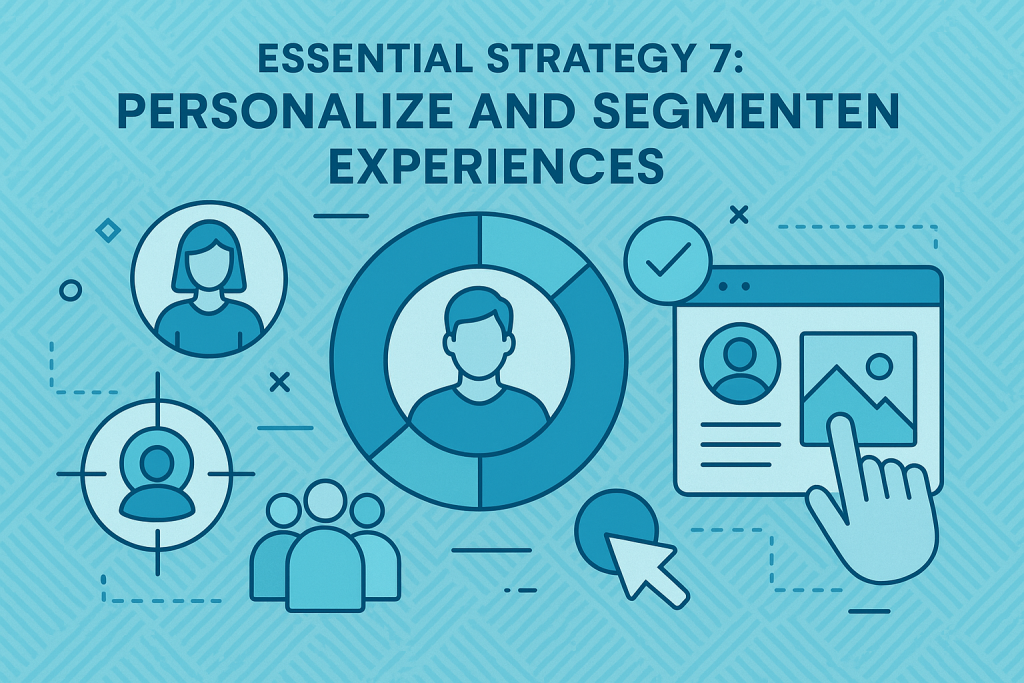
Behavioral segmentation utilizes website interaction data, content consumption patterns, and engagement history to understand visitor intent and preferences. Visitors who download technical whitepapers demonstrate different interests and needs than those who request pricing information or schedule demonstrations. Personalization strategies can leverage these behavioral signals to present relevant content and offers that align with demonstrated interests.
Account-based personalization represents a sophisticated approach, particularly relevant for B2B companies targeting specific high-value accounts. This strategy creates customized experiences for individual target companies, incorporating company-specific information, industry challenges, and competitive positioning. Account-based personalization can significantly improve conversion rates for target accounts by demonstrating a deep understanding of their specific needs and circumstances.
The integration of personalization with lead scoring and qualification processes enables more sophisticated lead management that accounts for both explicit information and behavioral signals. Personalized experiences can adapt based on lead scores, presenting different content and conversion pathways for high-quality leads versus early-stage prospects. This approach ensures that sales resources are allocated efficiently while providing appropriate experiences for all visitor types.
Visual Framework and Implementation
The successful implementation of B2B conversion rate optimization strategies requires comprehensive visual frameworks that translate complex data and strategies into actionable insights. Visual elements serve not only to enhance understanding but also to provide practical tools for implementation and ongoing optimization efforts.
B2B CRO Implementation Timeline
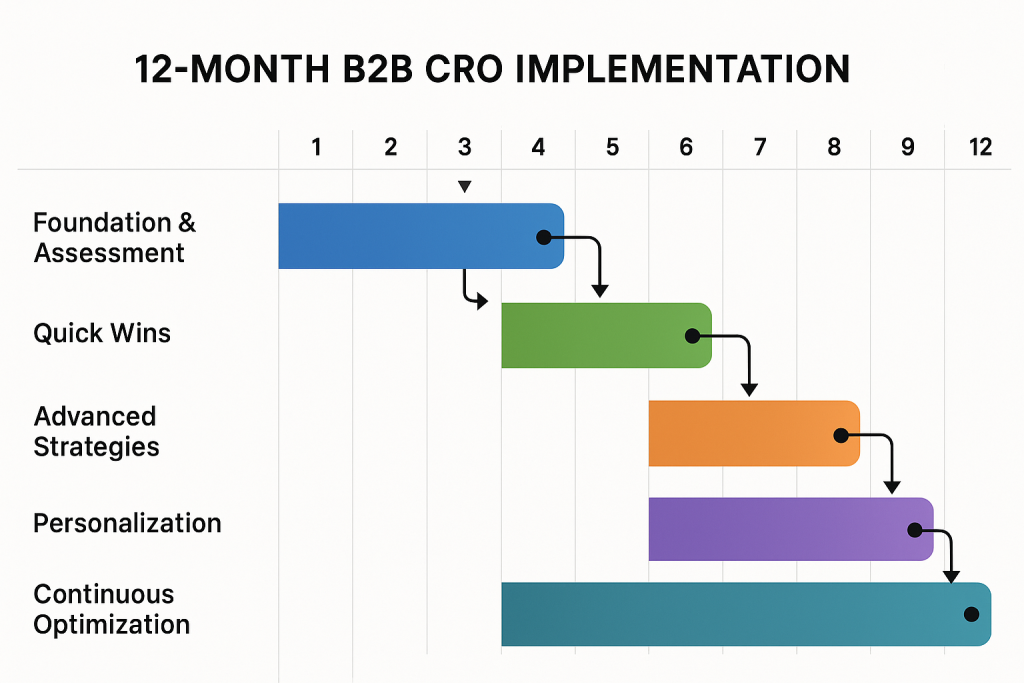
Strategic implementation timeline showing the recommended sequence and duration for implementing B2B CRO strategies over a 12-month period.
Educational Video Integration
Strategic integration of educational video content enhances understanding and provides additional value for readers seeking deeper insights into B2B conversion optimization strategies.
B2B Conversion Rate Optimization Fundamentals
Advanced A/B Testing for B2B Websites
Mobile Optimization for B2B Conversion
Action Plan for Implementation
The successful implementation of B2B conversion rate optimization requires a systematic approach that balances strategic planning with tactical execution. This comprehensive action plan provides step-by-step guidance for organizations seeking to improve their conversion performance through evidence-based optimization strategies.
Phase 1: Foundation and Assessment (Weeks 1-4)
The initial phase focuses on establishing the analytical foundation necessary for effective optimization efforts. Organizations must begin with comprehensive audits of current performance and identification of optimization opportunities.
| Week | Activity | Deliverable | Success Metric |
|---|---|---|---|
| 1-2 | Analytics and Measurement Setup | Comprehensive tracking implementation | 100% goal tracking accuracy |
| 3-4 | Competitive Analysis and Benchmarking | Industry benchmark report | Performance gap identification |
Phase 2: Quick Wins and Foundation Building (Weeks 5-12)
The second phase focuses on implementing high-impact optimizations that can deliver immediate results while building the foundation for more sophisticated strategies.
| Week | Activity | Expected Impact | Success Metric |
|---|---|---|---|
| 5-6 | Form Optimization | 10-15% completion rate increase | Reduced form abandonment |
| 7-8 | Landing Page Optimization | 15-25% conversion rate increase | Improved relevance scores |
| 9-10 | User Experience Improvements | Page speed under 3 seconds | Reduced bounce rates |
| 11-12 | Social Proof Integration | 5-10% trust signal impact | Increased engagement |
B2B CRO ROI Calculator
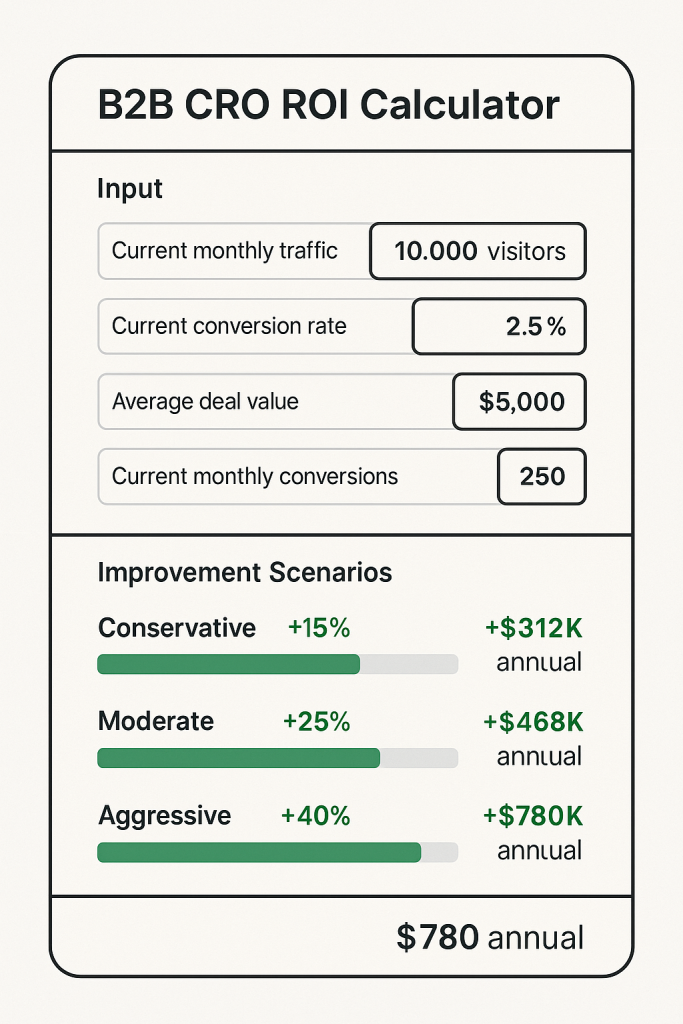
ROI calculator demonstrates the potential financial impact of B2B conversion rate optimization improvements across different scenarios.
Success Metrics and KPIs
| Metric Category | Specific KPI | Target Improvement | Measurement Timeline |
|---|---|---|---|
| Primary Metrics | Overall conversion rate | 15-25% increase | 12 months |
| Lead quality score | 20% increase in SQL rate | 6 months | |
| Secondary Metrics | Cost per acquisition | 10-15% decrease | 9 months |
| Mobile conversion rate | Close desktop gap | 6 months |
Future Outlook for B2B CRO
The landscape of B2B conversion rate optimization continues to evolve rapidly, driven by technological advances, changing buyer behaviors, and increasing competitive pressures. Understanding emerging trends and preparing for future developments enables organizations to maintain competitive advantages and capitalize on new optimization opportunities.
Artificial Intelligence and Machine Learning Integration
The integration of artificial intelligence and machine learning technologies represents the most significant trend shaping the future of B2B conversion optimization. Advanced AI applications are moving beyond simple automation to provide predictive insights and real-time optimization capabilities that were previously impossible.
Machine learning algorithms increasingly analyze vast amounts of user behavior data to identify patterns and predict conversion likelihood with remarkable accuracy. These predictive capabilities enable dynamic content presentation and personalized experiences that adapt to individual user characteristics in real-time. Future AI applications will likely include automated hypothesis generation for testing programs and intelligent optimization recommendations based on comprehensive data analysis.
Privacy and Data Protection Evolution
The evolving landscape of data privacy regulations and consumer expectations around data protection will significantly impact B2B conversion optimization strategies. Organizations must balance the desire for comprehensive user insights with respect for privacy rights and regulatory compliance requirements.
First-party data collection and utilization will become increasingly important as third-party data sources become less available and reliable. Organizations that develop sophisticated first-party data strategies will maintain competitive advantages in personalization and optimization capabilities while those relying on third-party data may face significant challenges.
Emerging Technology Integration
Several emerging technologies present significant opportunities for future B2B conversion optimization strategies. Augmented reality and virtual reality applications are beginning to provide immersive product demonstration and evaluation experiences that can significantly impact conversion rates in appropriate industries.
Blockchain technology may provide new approaches to trust and verification in B2B transactions, potentially impacting how social proof and credibility signals function in conversion optimization strategies. Internet of Things (IoT) integration could provide new data sources and touchpoints for optimization efforts.
Strategic Recommendations for Future Preparation
Organizations seeking to prepare for the future of B2B conversion optimization should focus on building flexible, data-driven capabilities that can adapt to changing technologies and market conditions. Investment in comprehensive analytics infrastructure and data governance processes provides the foundation for future optimization capabilities.
Developing organizational capabilities in artificial intelligence and machine learning applications enables organizations to capitalize on emerging optimization opportunities while building competitive advantages. This development should include both technical capabilities and organizational processes for implementing and managing AI-driven optimization strategies.
Key Takeaways
The comprehensive analysis of B2B conversion rate optimization reveals several critical insights that organizations must understand to achieve superior performance in increasingly competitive markets:
- Industry Performance Varies Dramatically: B2B conversion rates range from 1.1% in software development and B2B SaaS to 7.4% in legal services, with most industries falling between 2-5%. Organizations must benchmark against industry-specific standards rather than generic conversion rate averages to set realistic performance targets and identify optimization opportunities.
- Systematic Optimization Delivers Measurable ROI: Companies implementing comprehensive conversion rate optimization strategies achieve an average return on investment of 223%, demonstrating that systematic optimization efforts generate substantial business value beyond simple conversion rate improvements.
- Mobile Optimization Remains Critical: Despite B2B environments being traditionally desktop-centric, mobile optimization is essential as desktop conversion rates average 4.03% while mobile performance typically lags significantly. Organizations that successfully optimize mobile experiences gain competitive advantages as mobile usage continues to grow across all business segments.
- Data-Driven Insights Enable Precision Optimization: Advanced analytics including heat mapping, session recording, and AI-powered behavioral analysis provide unprecedented insights into user behavior and optimization opportunities. Organizations leveraging these sophisticated analytics capabilities can implement more targeted and effective optimization strategies than those relying on traditional web analytics alone.
- Simplification Often Outperforms Complexity: Research shows that 27% of form fillers abandon forms that take too long to complete, and 22% of customers abandon purchases due to overly complicated processes. Successful B2B optimization often involves removing unnecessary complexity rather than adding sophisticated features, with minimalistic approaches frequently delivering superior conversion performance.
Frequently Asked Questions
What is a good conversion rate for B2B websites?
B2B conversion rates vary significantly by industry, ranging from 1.1% to 7.4% according to comprehensive industry research. The overall median across all industries is 6.6%, but B2B-specific rates typically fall between 2-5%. Legal services achieve the highest rates at 7.4%, while B2B SaaS and software development companies average 1.1%. Organizations should benchmark against industry-specific standards rather than generic averages.
How long does it take to see results from B2B CRO efforts?
B2B conversion rate optimization typically requires 3-6 months to show significant results due to longer sales cycles and smaller traffic volumes compared to B2C environments. Initial improvements from quick wins like form optimization may be visible within 4-8 weeks, while comprehensive optimization programs require 6-12 months to demonstrate full impact. Statistical significance in B2B testing often requires longer periods due to lower traffic volumes.
What’s the difference between B2B and B2C conversion optimization?
B2B conversion optimization involves longer sales cycles (2+ months vs. minutes to days), multiple decision-makers (6+ stakeholders vs. individual decisions), higher transaction values, rational decision-making processes, and detailed evaluation requirements. B2B optimization focuses on lead generation and nurturing rather than immediate purchases, requires more comprehensive information presentation, and must address risk mitigation concerns that are less prominent in B2C environments.
How much should companies invest in conversion rate optimization?
Companies typically allocate 5-15% of their digital marketing budget to conversion rate optimization efforts, with businesses using CRO tools reporting an average ROI of 223%. The investment should scale with website traffic and conversion volume, as higher-traffic sites can achieve statistical significance faster and generate greater absolute returns from percentage improvements. Organizations should prioritize CRO investment based on current conversion performance gaps and available optimization opportunities.
What tools are essential for B2B conversion rate optimization?
Essential B2B CRO tools include comprehensive analytics platforms (Google Analytics 4), heat mapping and session recording tools (Hotjar, Crazy Egg), A/B testing platforms (Optimizely, VWO), customer relationship management systems for attribution tracking, and marketing automation platforms for lead nurturing. Advanced implementations may include AI-powered personalization tools, predictive analytics platforms, and cross-device attribution solutions.
How do you measure the success of B2B conversion optimization?
B2B CRO success measurement requires multiple metrics, including overall conversion rate improvements, lead quality score increases, cost per acquisition reductions, and revenue attribution to optimization efforts. Advanced measurement considers sales-qualified lead rates, customer lifetime value impacts, and sales cycle length changes. Attribution modeling must account for multiple touchpoints and extended sales cycles typical in B2B environments.
What are the biggest mistakes in B2B conversion optimization?
Common B2B CRO mistakes include focusing solely on traffic generation rather than conversion improvement, implementing changes without proper testing and measurement, over-complicating forms and conversion processes, neglecting mobile optimization, failing to account for multiple stakeholders in the buying process, and not aligning optimization efforts with sales processes and broader business objectives.
References
- Unbounce. (2025, April 24). B2B conversion rate optimization: 2025 strategies & benchmarks.
- Econsultancy and RedEye. (2024). Conversion Rate Optimization Survey Results.
- First Page Sage. (2025, May 8). B2B Conversion Rates By Industry – 2025.
- BigSur AI. (2024, August 20). 15 Must-Know Conversion Rate Optimization (CRO) Statistics in 2025.
- First Page Sage. (2025). B2B buyer behavior research findings.
- Unbounce. (2025). Conversion rate calculation methodology.
- HubSpot. (2025, February 27). Optimizing B2B Conversion Rates — All My Tips and Strategies.
- First Page Sage. (2025). Industry conversion rate analysis.
- Unbounce. (2025). Conversion Benchmark Report.
- First Page Sage. (2025). Technology sector conversion rate analysis.
- Econsultancy and RedEye. (2024). B2B conversion satisfaction survey.
- Breakthrough3X. (2024). Desktop vs mobile conversion rates.
- First Page Sage. (2025). Form abandonment research.
- First Page Sage. (2025). B2B buyer journey analysis.
- BigSur AI. (2024). CRO ROI statistics.
- Unbounce. (2025). Landing page optimization strategies.
- First Page Sage. (2025). Legal services CRO strategies.
- First Page Sage. (2025). Manufacturing CRO strategies.
- First Page Sage. (2025). B2B SaaS CRO strategies.
- HubSpot. (2025). Expert interview with Daniel Lynch.
- Baymard Institute. (2024). Checkout abandonment research.
- First Page Sage. (2025). Form completion research.
- Breakthrough3X. (2024). Website navigation best practices.
- First Page Sage. (2025). HVAC services optimization strategies.
- First Page Sage. (2025). IT services optimization strategies.
- HubSpot. (2025). Daniel Lynch interview on user behavior analysis.
- McKinsey. (2025). AI applications in B2B sales optimization.
- McKinsey. (2025). Cross-selling optimization research.
- Breakthrough3X. (2024). Desktop vs mobile conversion rates.
- First Page Sage. (2025). Mobile optimization by industry.
- First Page Sage. (2025). Legal services trust building strategies.
- First Page Sage. (2025). Manufacturing social proof strategies.




